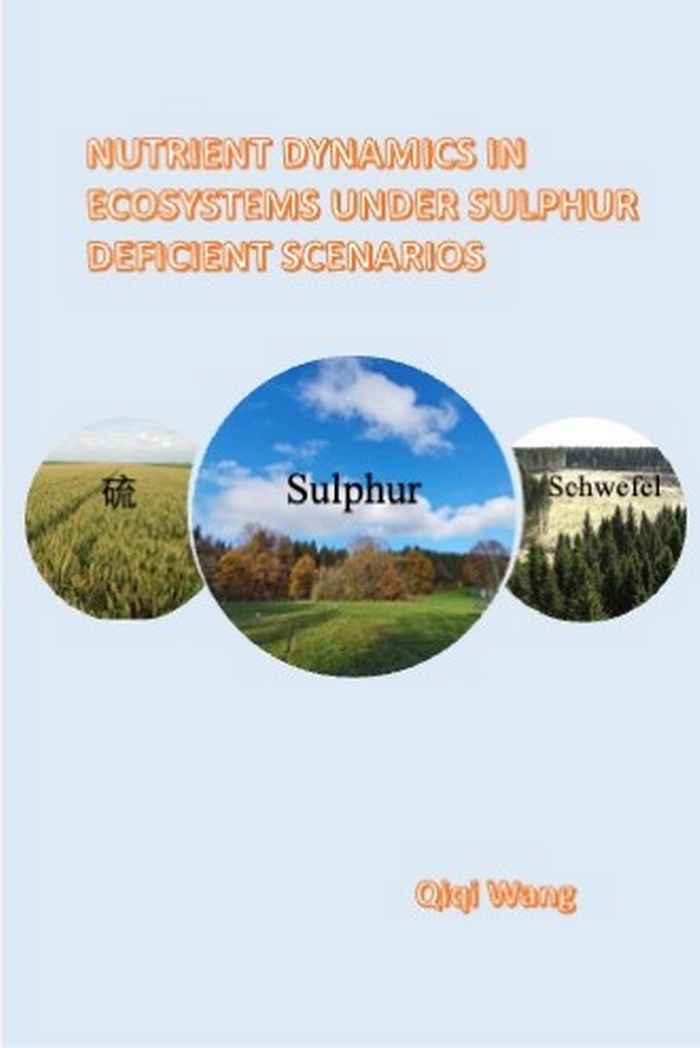PhD defence ceremony by Qiqi Wang
- Date
- 11 March 2024
- Time
- 14:00
- Location
- Agnietenkapel

Sulphur (S) is an essential macronutrient and ranked in importance with N and phosphorus (P) in the formation of proteins and essential amino acids. S is also one of the major nutrients limiting ecosystem productivity. However, the S cycling has been always overlooked relative to carbon (C), nitrogen (N) and phosphorus (P), limited information has been reported about the S stocks, S transformations and the response of S dynamics to anthropogenic disturbance in different ecosystems. Therefore, there is urgent need to explore the S dynamics and uncover the underlying mechanisms, especially under the S deficiency scenarios. Thus, we explored soil S stocks, soil organic S decomposition or soil natural isotopes in deforested catchment, recultivated agriculture and meadow grassland systems.
In Chapter 2, we investigated the spatial-temporal dynamics of stream dissolved organic carbon (DOC) and sulphate and other hydrological parameters in three observation stations in a deforested catchment (Wüestebach, Germany), which have different proportions of deforested area. Based on ten-year datasets, we found that DOC increased by 26% naturally, while DOC increased by 59% after deforestation. However, there is slightly changes in sulphate after deforestation during the 10-year time series analysis. The Wavelet transform coherence (WTC) analysis revealed that DOC negatively correlated with sulphate and runoff, but positively correlated with total iron concentration. Additionally, WTC analysis indicated the strong deforestation effects on their non-stationary relationships among each other, which represented as the vanish of the significant correlation after the deforestation. Our results indicated that DOC transport via organic-mineral complexes in this catchment. Whereas, sulphate concentrations were better explained by hydrological factors (runoff and water temperature). WTC analysis indicates that within this low mountainous forest catchment deforestation levels over 25% affected the coupling of S and C cycling substantially more strongly than ‘natural’ environmental changes.
Recultivation aims to compensate for negative ‘legacy’ effects on soils from past open-cast mining when restoring land to productive agricultural systems. Chapter 3 mainly studied the belowground sulphur (S) cycle that develops along a soil chronosequence after recultivation (Inden, Germany), especially for the deeper part of the soil using 35S isotope in a short-term incubation experiment. Firstly, we investigate the underground S stock in different soil depths after 1, 8, 14, 24 and 48 years of recultivation, we found that soil organic carbon (TOC), total nitrogen and total sulphur (TS) significantly increased after 48-year recultivation in surface soil. However, no significant changes in nutrient content were observed in subsurface soils along the soil chronosequence. Then, we compare the differences in 35S-labelled methionine depletion among different recultivation age, recultivation ages (≥ 8 years) led to fast immobilisation of 35S and less 35S being released as sulphate throughout the profile to maintain microbial stoichiometric equilibrium in older soils. Significant changes in the organic S partition were observed at age 8 after the soil was recultivated with N-fixing alfalfa. Whereas, after that (≥ 14 years), soil organic S partition showed no significant changes when a conventional tillage and cropping system had been well established. Weak correlation relationships (Pearson analysis) between sulphate and soil TOC, TN and TS in subsurface soil indicated that the microbial metabolisms of organic S as sulphate in subsoil were regulated by more complex factors rather than solely soil nutrient availability.
The combined use of lime and mineral fertiliser is well known to mitigate soil acidification and improve soil fertility. In Chapter 4, we explored how the long-term lime with mineral nutrients fertilisers application affect the soil C and S cycling and the underlying mechanism. We hypothesized (ii) Long-term lime with mineral nutrients would benefit soil C and S cycling, this mainly attributed to the expected increased soil pH resulted from lime addition, or the increased nutrient availability from stoichiometrically balanced mineral fertilisers. (ii) Long-term lime with mineral nutrients constrained soil C and S cycling because of the nutrient limitation under imbalanced mineral fertilisers application. To test our hypothesis, we evaluated the biodegradation of methionine (organic S), gross S transformation and microbial S utilisation using 35S and 14C dual-labelling within an 82-year upland grassland system (Rengen, Germany). Long-term lime plus mineral nutrients fertilisers on soil inorganic have negative effect on microbial inorganic S immobilisation. This attributed to the decreased C availability or the increased soil pH from lime addition. While the effects of long-term lime plus mineral nutrients fertliisers on gross S fluxes and carbon use efficiency (CUE) depend on how the mineral nutrient applied. Long -term lime with imbalanced nutrient resulted in the decrease of CUE and Gross S transformation because of the low P availability. Long -term lime with balanced N and P nutrient leads to the increase of CUE and gross S transformation, which is mainly due to high P availability. The effect of P bioavailability on global soil S cycling is highlighted for the first time. Our study emphasises the adverse consequences on C or P bioavailability resulted from the long-term lime application, particularly when combined with the N fertiliser. Therefore, careful consideration on the application of lime in grassland managements is warranted. The incorporation of balanced NP fertilisers or organic amendments along with lime is recommended to mitigate the potential C or nutrient loss.
Soil nutrient content and stoichiometry are important factors regulating soil nutrient cycling and microbial activity. Isotopes at natural abundance level are effective to identify and indicate biogeochemical processes in nutrient cycling. In Chapter 5, we investigated the fertilisation effect on C, N, P and S content and stoichiometry as well as natural abundance of 14C, 15N and 34S values in topsoil and subsoil based on the same long-term experiment of Rengen grassland as used in Chapter 4. Fertilisation significantly changed soil nutrient content and stoichiometry. Specifically, the soil C/N/P/S stoichiometry ratios under these treatments in topsoil were 109:8:1:1 (Control), 63:5:1:1 (Ca), 70:6:1:1 (CaN), 37:4:2:1 (CaNP), 51:5:2:1 (CaNPKCl), 45:4:2:1 (CaNPK2SO4). In subsoil, the C/N/P/S stoichiometry ratios were 77:7:2:1 (Control), 61:5:1:1 (Ca), 58:5:0.9:1 (CaN), 47:5:2:1 (CaNP), 62:5:2:1 (CaNPKCl), 56:5:2:1 (CaNPK2SO4). Fertilisation had no significant effect on soil δ13C in topsoil and subsoil, δ34S value highly increased only with S fertiliser addition. Soil natural δ15N abundance significantly increased with N addition and depths. Additionally, we explored whether soil C-N-S cycling coupled with each other. Our results indicated that soil carbon and nitrogen were strongly coupled in this grassland. However, soil natural δ34S abundances showed no mutual relationships with δ13C and δ15N in topsoil or subsoil, which indicated that the δ34S is less linked with organic matter turnover, and decoupled with C and N. The δ34S value in subsoil was more linked with soil Fe or Al minerals. The decoupling soil C, N and S cycles under fertilisation in this meadow suggested that nutrient stoichiometry and natural isotopes are effective to uncover the biogeochemical linkage of elements.
